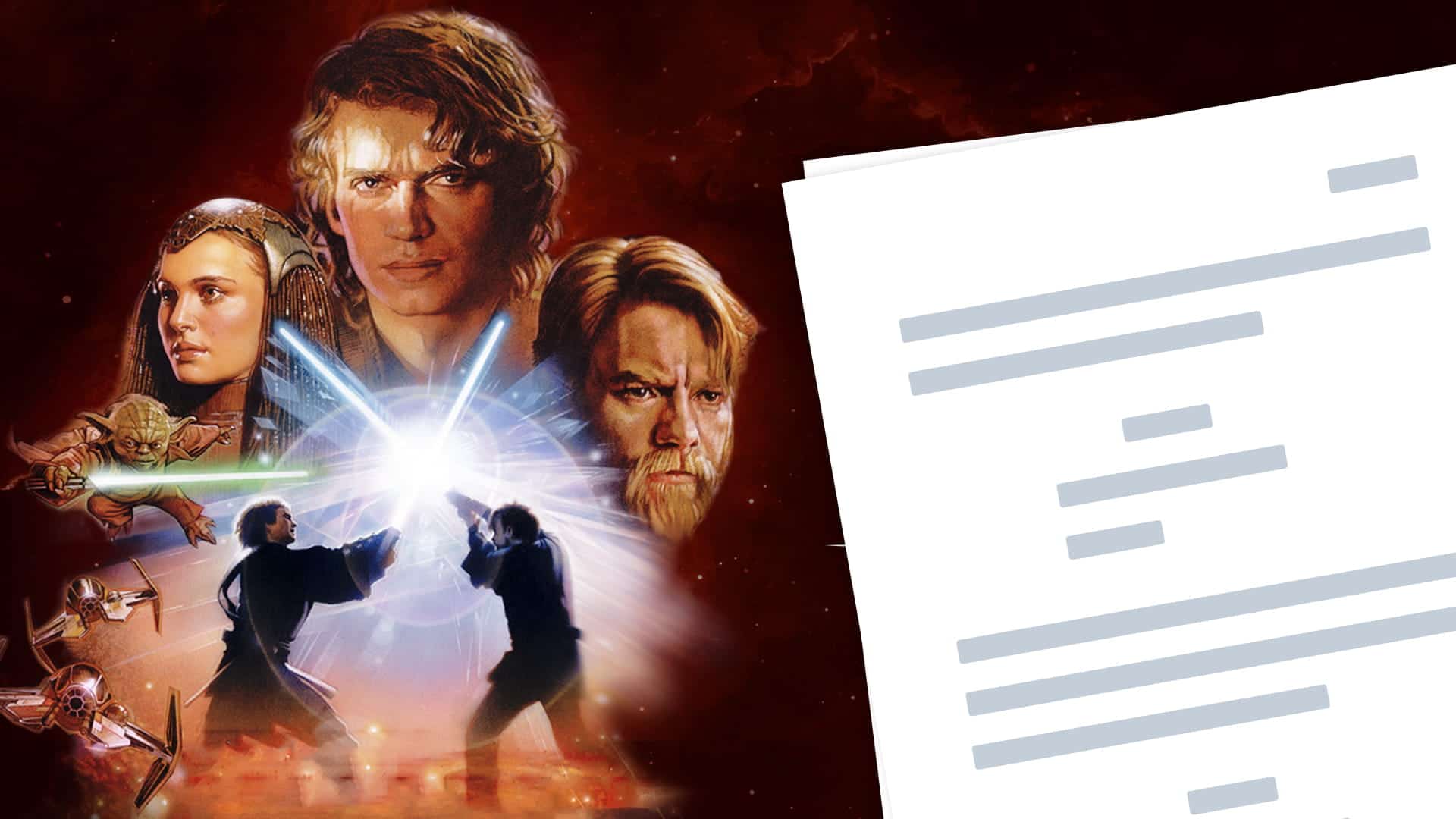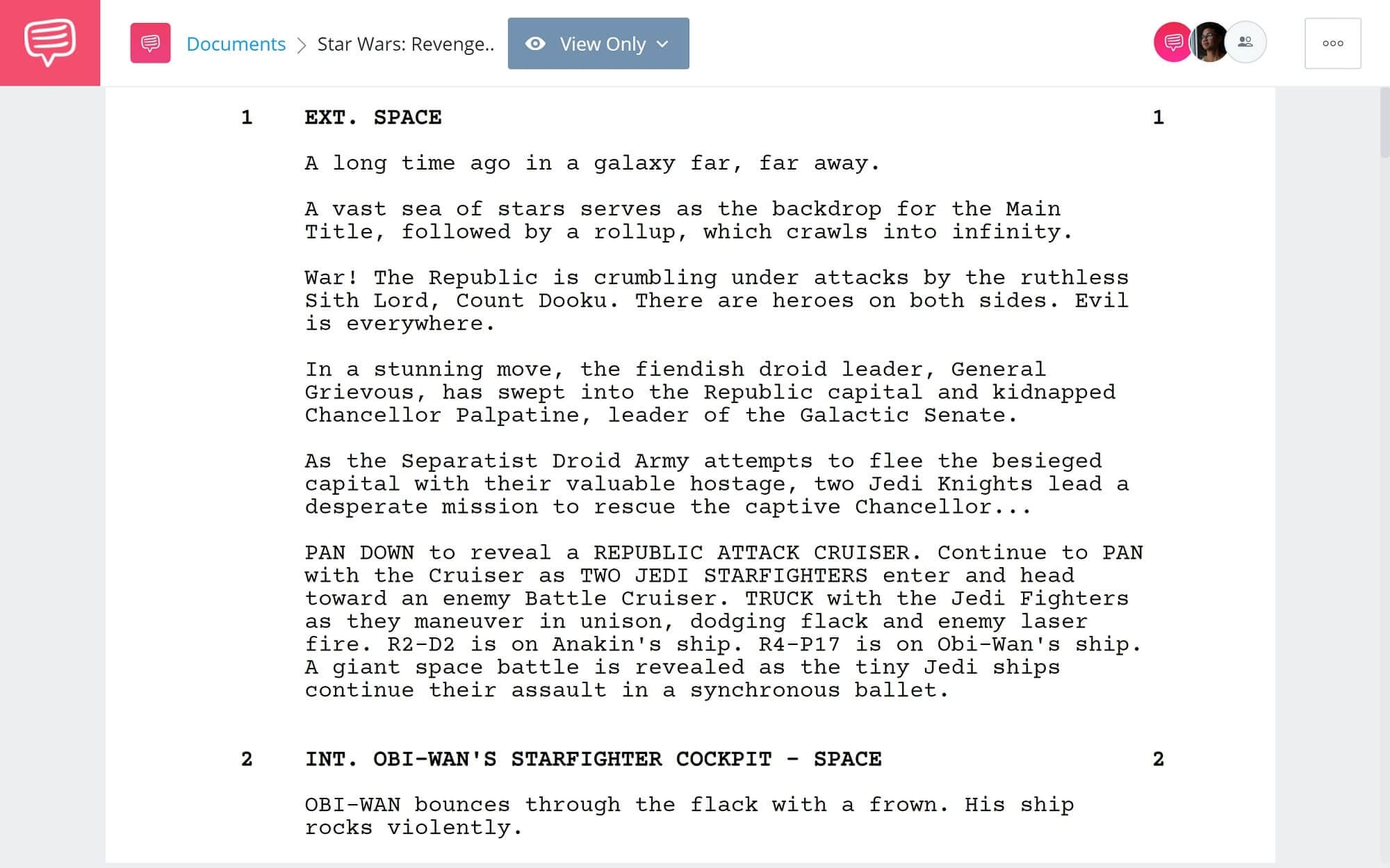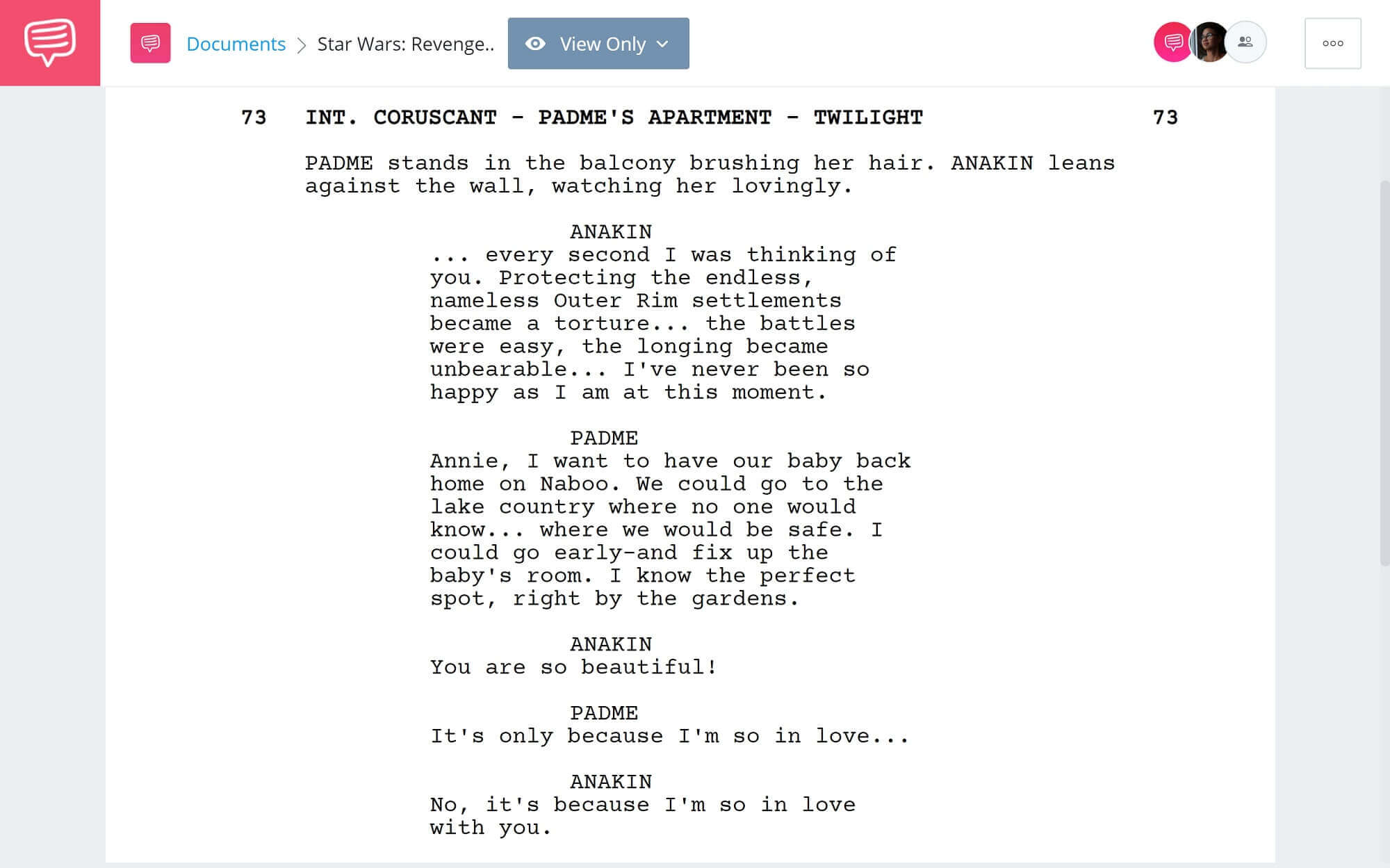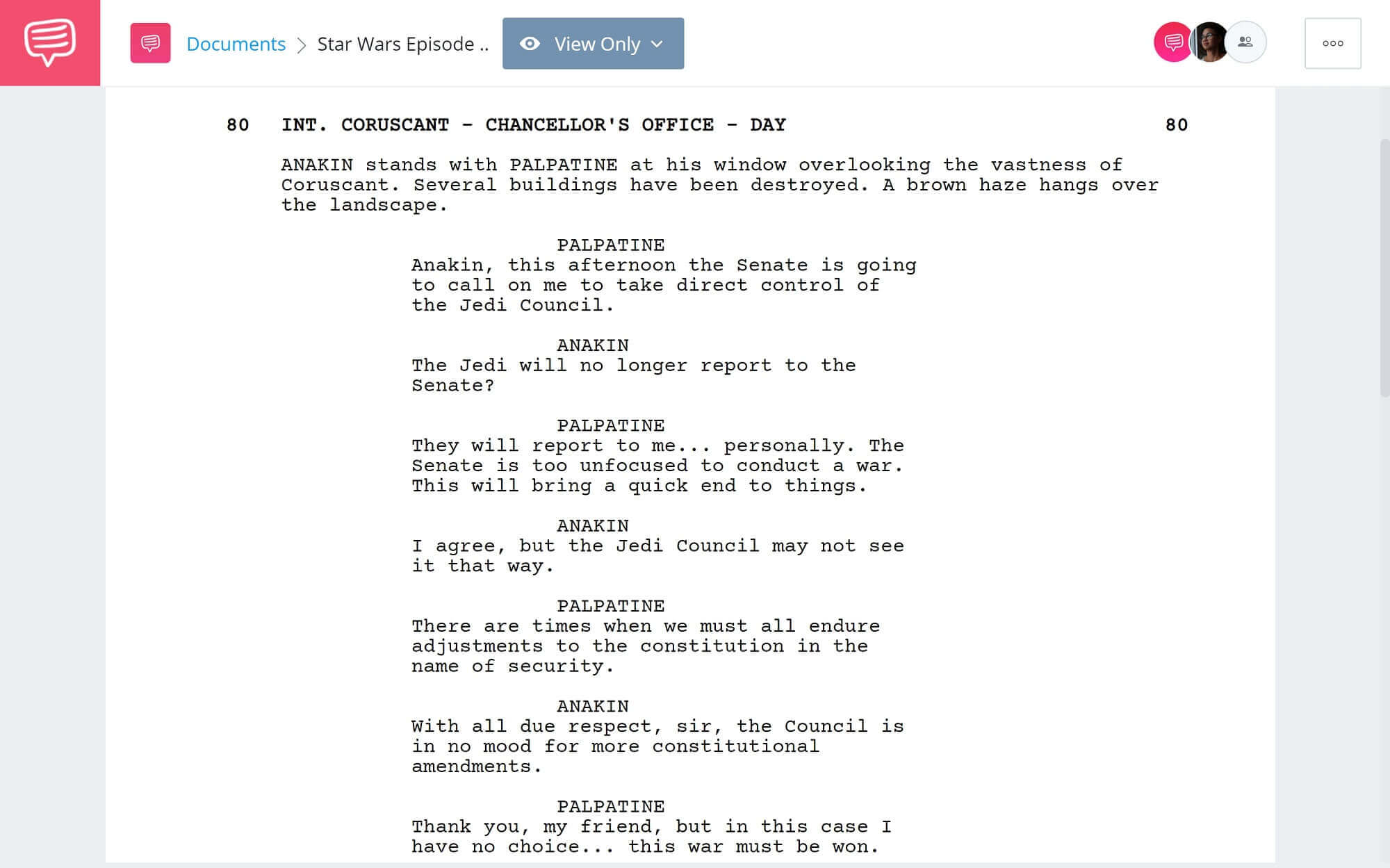Star Wars Episode III: Revenge of the Sith (2005) is considered the best of the Star Wars prequels by critics and fans who credit its improvement over trilogy predecessors The Phantom Menace (1999) and Attack of the Clones (2002) to a richer and more compelling story. This sentiment is not universally shared, however, as the movie’s detractors believe that the Revenge of the Sith script suffers from the same problems: flat characters, wooden dialogue, and problematic plotting.
This analysis for screenwriters will examine some of what works and what doesn’t in the Star Wars Episode 3 script in terms of elements such as action, dialogue, pacing, allegory and theme. Make sure to download a copy of the screenplay below to read along as we do our analysis!


WHO WROTE STAR WARS EPISODE 3?
Written by George Lucas, Tom Stoppard
George Lucas, who also directed the film, is one of the most successful storytellers in the history of cinema. In addition to writing the scripts and/or stories for the first six Star Wars films (1977-2005), he also wrote the stories for the Indiana Jones films (1981-2008), and co-wrote the script for American Graffiti (1973), his first big hit as a director.
Although Lucas is credited as the sole writer on the film, Tom Stoppard, the legendary Czech-born British playwright and screenwriter of Rosencrantz and Guildenstern Are Dead, did a light “polish” (his words), focusing mostly on the dialogue. He previously revised dialogue for Indiana Jones and the Last Crusade (1989).
Star Wars Revenge of the Sith Script Teardown
STRUCTURE OF The REVENGE OF THE SITH SCRIPT
The Revenge of the Sith plot breaks down as follows:
Exposition
War has erupted between the Galactic Republic — ruled by the Senate and protected by Yoda and the Jedi Council — and a “separatist” movement led by evil Sith Lords.
Inciting Incident
Chancellor Palpatine, leader of the Galactic Senate, is kidnapped by the Sith Lord Count Dooku. The Council sends two Jedi Knights — Obi-Wan Kenobi and Anakin Skywalker — through a massive battle to rescue the Chancellor from the star cruiser where he is being held.
Plot Point One
The Jedi kill Dooku, but another villain, General Grievous, escapes during the battle. Anakin and Obi-Wan return the Chancellor to the Senate, which determines the war cannot end until Grievous and his droid army are destroyed.
Plot Point Two
The movie reveals that Anakin is secretly married to Senator Padmé Amidala, his childhood love, who is also pregnant. When Anakin dreams that Padmé will soon die, he vows to do whatever he can to prevent it. The Chancellor convinces Anakin that he may be able to save her by learning Dark Side powers — but only if Anakin himself embraces the Dark Side.
Rising Action
Obi-Wan Kenobi travels to the Outer Rim to track down General Grievous. After a battle, Obi-Wan kills Grievous and dispatches his army. The Jedi Council determines that Chancellor Palpatine must give up the emergency war powers granted to him now that the war has ended.
Midpoint
Anakin learns that the Chancellor is the Sith Lord the Jedi have been looking for. He reports this and several Jedi go to arrest the Chancellor. During the ensuing fight, Anakin decides that the Chancellor must live so that he may save Padmé, and helps him vanquish the Jedi. Having fully embraced the Dark Side, Anakin becomes the Chancellor’s Sith apprentice, Darth Vader.
Plot Point Three
Now revealed as a Sith Lord, and with Darth Vader as his ally, the Chancellor wipes out most of the Jedi and dissolves the Senate. Citing security concerns, he declares himself emperor.
Build Up
As the two remaining Jedi, Obi-Wan must attempt to destroy his former friend and apprentice, Anakin, who is now Darth Vader; while Yoda attempts to take down Emperor Palpatine.
Climax
Obi-Wan and Padmé travel to the lava planet Mustafar to confront Anakin. In his anger at her perceived betrayal, Anakin attacks Padmé, then fights Obi-Wan until Obi-Wan defeats him and leaves him to die. Yoda, meanwhile, fights the Emperor but fails to defeat him.
Finale
Palpatine rescues what’s left of Anakin and encases him in Darth Vader’s iconic black suit. Padmé dies giving birth to the twins, Luke and Leia. The infants, along with Yoda and Obi-Wan, are forced to go into hiding from the newly formed Empire. The stage is now set for the original Star Wars trilogy.
Revenge of the Sith Script Takeaway #1
Action vs Dialogue
“Show, don’t tell,” one of the hallowed rules of storytelling, is especially crucial in the visual medium of cinema. Indeed, Alfred Hitchcock, one of the most accomplished visual storytellers, believed that a movie needed very little dialogue to tell a story.
George Lucas has often been accused of having a “tin ear” for dialogue — writing lines that are considered neither poetic nor realistic dialogue, and are often cliches to avoid. This is less noticeable in the original trilogy, partially because Lucas did not write the screenplays for The Empire Strikes Back (1980) or Return of the Jedi (1983), but it is pronounced in the prequels.
Listen to the dialogue in this sequence:
Revenge of the Sith Dialogue
What makes the dialogue here especially unnecessary is that Lucas has already made the goals and stakes clear through action and visuals. Corny lines such as “You’re shorter than I expected,” “This time you won’t escape,” and “Another happy landing,” only distract from an engaging experience. Lucas could have pared the dialogue down throughout the Star Wars Episode 3 script and lost nothing in the storytelling. For the screenwriter, the lesson here is that less is more.
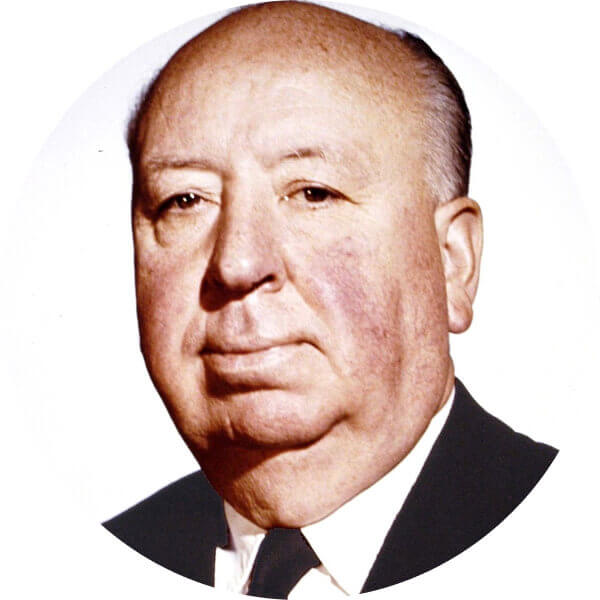
“In many of the films now being made, there is very little cinema: they are mostly what I call 'photographs of people talking.' When we tell a story in cinema we should resort to dialogue only when it's impossible to do otherwise. I always try to tell a story in the cinematic way, through a succession of shots and bits of film in between.”
— Alfred Hitchcock
Indeed one of the main criticisms of the earlier prequel movies was that they were often, in Hitchcock’s words, “photographs of people talking” — long scenes of leaden dialogue, often set in inert locations such as drawing rooms and council chambers. Episode 3 arguably improves on the earlier films in this regard (possibly due to Tom Stoppard’s work on the script), and the film is better-paced. But the first hour in particular still features too many scenes of characters talking at each other.
We imported the Star Wars Revenge of the Sith script into StudioBinder's screenwriting software to examine these specific scenes in-depth. After analyzing these scenes here, compare them to other scenes in your downloaded copy! Here's a scene that contains particularly cringe-worthy exchange between Anakin and Padmé.
Revenge of the Sith dialogue • Read Scene
How to fix this? Lucas himself has the answer elsewhere in the film. The key to delivering exposition through dialogue is to do it through conflict, which is much more compelling, as in the famous climax featuring iconic Anakin vs Obi-Wan dialogue.
Anakin vs Obi-Wan script • “You are lost!”
The entire prequel trilogy builds to the Anakin vs Obi-Wan fight. Scripting their earlier differences through civilized discussion, as we have seen, subdues the dramatic tension — the engine that drives every story. In the climax, however, ideological differences earlier intoned through inert dialogue exchanges between Revenge of the Sith characters are passionately expressed during combat.
The molten lava meanwhile acts as a visual metaphor for the heat and intensity of the Anakin vs Obi Wan fight script. Script lines such as “I have failed you,” and “Well, then you are lost,” sound more natural, as we understand that the personal and the political stakes couldn’t be higher.
The audience, riveted by the action and tension, doesn't notice — or care — if the film is delivering exposition or bluntly articulating some of the common themes in movies.
Revenge of the Sith Script Takeaway #2
Themes in Episode III
The Episode 3: Revenge of the Sith script weaves parallel themes along the personal and the political. The personal themes are more famous to viewers, familiar as they are from the earlier trilogy. They include:
- The internal conflict between light and dark
- The corrupting influence of power
- Selfishness vs sacrifice
- Impetuousness vs patience
- The dangers of self-righteousness and narrow-minded thinking
These themes play out predominantly between Anakin and other Revenge of the Sith characters. They come to a head before the climax as Obi-Wan and Padmé try to disburse Anakin of his delusions of grandeur:
Themes in the Revenge of the Sith script • “Your new Empire?”
The personal themes listed above and dramatized in this scene are central to Star Wars. They play out not only in the prequel trilogy, but also between Luke Skywalker and Darth Vader in the original trilogy, and between Rey and Kylo Ren in the sequel trilogy.
Although Lucas is more famous for these personal themes, his movies are sometimes political as well. His generation was haunted by the Vietnam war and this is reflected both at the end of American Graffiti and allegorically in Return of the Jedi, when the “primitive” Ewoks — representing the Viet Cong — repel the far more technologically advanced Empire — representing the U.S. military — from their forest environment. Here's a video that details the parallels between Vietnam that Lucas brought to a galaxy far, far away.Star Wars and the Vietnam War
As the video shows, Lucas was anti-authorarian and had problems with overreaching governments, including that of the United States. As you can read in the Star Wars Revenge of the Sith script PDF linked above, the movie begins with an opening text that reads, “There are heroes on both sides. Evil is everywhere.”
Revenge of the Sith summary
While this may at first glance seem simplistic, the idea that evil is everywhere is a central theme for Lucas in the prequels, in which the Jedi — nominally the “good” guys — are shown to be as willing as the Sith to abandon democratic values when it suits their purpose.
In this scene, a Jedi attempts an extrajudicial killing of the Chancellor.
“He’s too dangerous to be left alive!”
Revenge of the Sith differs from most Star Wars films in that its political themes go far beyond vague references and the simplicity of “Empires are evil.” As we will see below, the Revenge of the Sith plot is an allegory for the way Lucas felt about U.S. politics and policies in the early 2000s.
Revenge of the Sith Script Takeaway #3
Allegory in Episode III
Science fiction often allegorizes real-life political systems and situations as a way to comment on them, as in George Orwell’s 1984 or Children of Men (2005). These allegories usually take the form of cautionary tales — a warning about what might happen if we don’t change our ways.
The Star Wars Episode 3 script is one such allegorical cautionary tale. Lucas was writing it just after 9/11 and during the buildup to the Iraq War, and he weaves his concerns about the fraying of democratic institutions through specific references in the script.
Among other things, the movie echoes controversies at the time surrounding the Patriot Act. Justifying his wartime powers, Palpatine says, “There are times when we must all endure adjustments to the constitution in the name of security.” Read how Lucas dramatizes these ideas in the scenes below and then find more allegorical material in your Star Wars Revenge of the Sith script PDF.
Sci-fi Allegory • Read Scenes
Later, Padmé says to Anakin, “What if the democracy we thought we were serving no longer exists, and the Republic has become the very evil we've been fighting to destroy?” Anakin responds, “You're sounding like a Separatist,” which echoes President Bush’s famous remark, “Either you are with us, or you are with the terrorists.” So that no one misses the reference, Lucas has Anakin all but quote this verbatim late in the film.
Star Wars Episode 3 quotes
While the Revenge of the Sith plot comments on specific issues of its era, Lucas’ message that “Democracies aren’t overthrown, they’re given away,” echoed below in Padmé's famous line, is also timeless, giving the movie continued relevance.
Revenge of the Sith dialogue
While being overtly political can kill a movie — nobody wants to be preached at — the Star Wars Revenge of the Sith script more successfully allegorizes contemporary politics within the action and emotion of the story than the earlier prequels.
UP NEXT
Read and download more scripts
Despite its flaws, and the instructive lessons they present for screenwriters, the Star Wars Revenge of the Sith screenplay is a resonant and powerful sci-fi allegory. If you want to continue reading screenplays, we have similar titles such as the original Star Wars (1977), The Avengers (2012), and The Matrix (1999) in our screenplay database. Browse and download PDFs for all of our scripts as you read, write and practice your craft to become the next great screenwriter.
